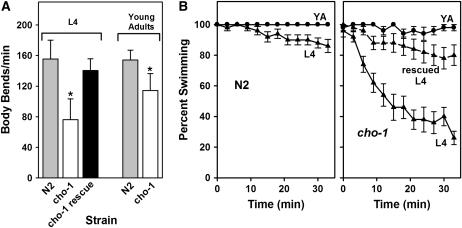Figure 4.—
cho-1 mutants exhibit reduced initial swimming rates and fail to sustain swimming over an extended time. (A) Swimming rates. Data are presented as body bends per minute plus or minus standard deviation for 25 animals. cho-1 L4 larvae were significantly more impaired than were young adults. Expression of the CHO-1∷GFP fusion protein rescued the L4 swimming defect. Values that are significantly different (P < 0.001; Mann–Whitney U-test) from wild type are indicated (*). (B) The percentage of animals actively swimming was scored at 3-min intervals for a 33-min time course. Data are presented as the percentage of animals swimming, plus or minus standard error of the mean, for a total of 50 animals at each time point. cho-1(tm373) L4 larvae exhibited a dramatic decline (fatigue) in swimming rate, whereas the young adults (YA) did not fatigue over the duration of the experiment. Expression of the CHO-1∷GFP fusion protein rescued the L4 fatigue phenotype.

